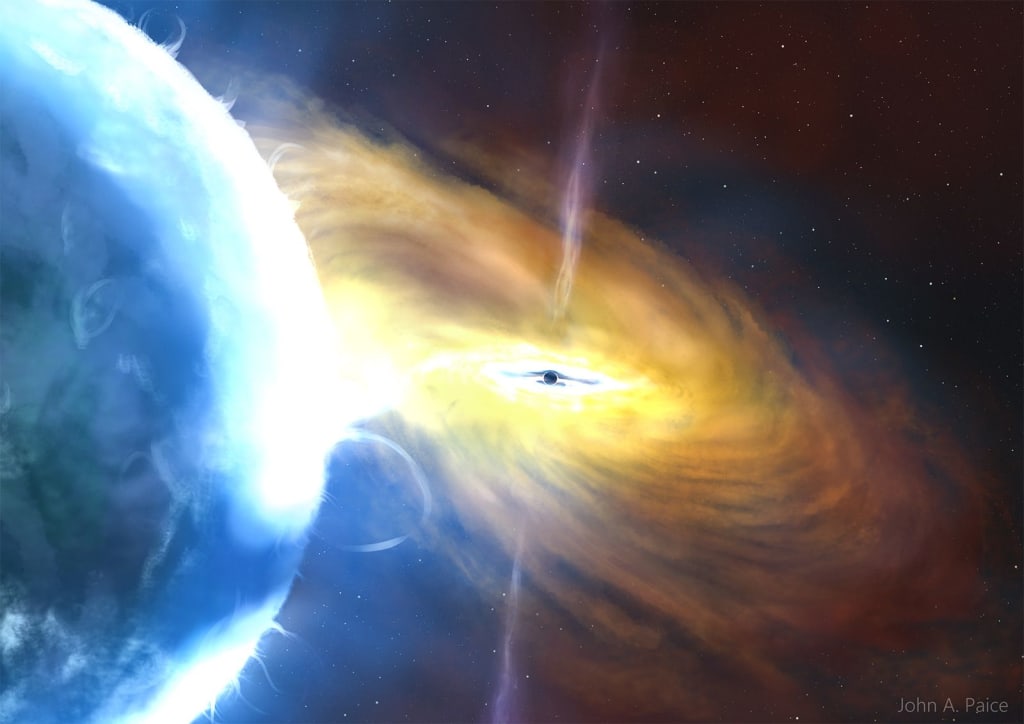ASTRONOMERS WITNESSED THE LARGEST COSMIC EXPLOSION EVER RECORDED
The explosion, known as a "supermassive black hole eruption," was detected by a network of telescopes located around the world. These telescopes, working together as part of an international collaboration, captured the immense energy released by the black hole at the heart of the galaxy cluster.

A cosmic explosion, also known as a stellar explosion or astral explosion, refers to a powerful event that occurs in outer space, involving the release of an enormous amount of energy. These explosions can take place in various celestial bodies, including stars, supernovae, gamma-ray bursts, and even in the form of cosmic collisions.
One of the most well-known types of cosmic explosions is a supernova. This occurs when a massive star reaches the end of its life cycle and undergoes a catastrophic collapse. The core of the star collapses under its own gravity, causing an intense explosion that releases an immense amount of energy into space. This explosion is so powerful that it can outshine an entire galaxy for a brief period.
Another type of cosmic explosion is a gamma-ray burst (GRB). GRBs are among the most energetic events in the universe and are believed to be caused by the collapse of massive stars or the collision of neutron stars. They release a burst of high-energy gamma rays that can be detected from billions of light-years away. These explosions can last from a few milliseconds to several minutes and can emit more energy in that short time than the Sun will emit over its entire lifetime.
Cosmic collisions, such as the merging of galaxies or the collision of black holes, can also result in explosive events. When two massive objects collide, gravitational forces can cause an enormous release of energy, creating shockwaves, jets of particles, and the formation of new celestial objects.
Astronomers Witness the Largest Cosmic Explosion Ever Recorded
In a groundbreaking discovery, astronomers have recently observed the largest cosmic explosion ever recorded. This extraordinary event, which occurred in a distant galaxy cluster, provides invaluable insights into the powerful forces shaping the universe.
The explosion, known as a "supermassive black hole eruption," was detected by a network of telescopes located around the world. These telescopes, working together as part of an international collaboration, captured the immense energy released by the black hole at the heart of the galaxy cluster.
The explosion was estimated to be five times more powerful than any previous cosmic explosion ever witnessed. The supermassive black hole, located over 390 million light-years away, ejected an enormous amount of matter and energy into space. The blast wave, traveling at speeds close to the speed of light, spanned hundreds of thousands of light-years.
The event, which occurred billions of years ago, provides astronomers with a unique opportunity to study the early universe's dynamics. By analyzing the data collected from this colossal explosion, scientists can better understand the processes that shape galaxies and galaxy clusters.
One of the key findings from this observation was the confirmation of the relationship between supermassive black holes and the galaxies in which they reside. It is believed that these explosions, known as active galactic nuclei, play a significant role in regulating the growth of galaxies by expelling matter and energy.
Furthermore, the study of this explosion sheds light on the mysteries surrounding black holes themselves. While black holes are notoriously difficult to observe directly, their activity can be inferred through their interaction with surrounding matter. The colossal eruption observed in this galaxy cluster offers vital clues about the behavior and dynamics of these enigmatic cosmic entities.
The detection of this colossal explosion was made possible by advancements in observational technology and the collaboration of scientists worldwide. The network of telescopes used in this study allowed for precise measurements of the energy released, providing a more comprehensive understanding of the event.
As astronomers continue to analyze the data collected from this extraordinary observation, it is anticipated that further insights into the nature of supermassive black holes and their impact on the cosmos will be revealed. This discovery marks a significant milestone in our understanding of the universe and opens up new avenues of exploration for future astronomical research.
In conclusion, the recent observation of the largest cosmic explosion ever recorded by astronomers offers a fascinating glimpse into the power and dynamics of the universe. This extraordinary event not only provides valuable insights into the behavior of supermassive black holes but also enhances our understanding of the forces shaping galaxies and galaxy clusters. As scientists continue to unravel the mysteries of the cosmos, this discovery will undoubtedly serve as a crucial stepping stone toward a deeper understanding of the universe we inhabit.
About the Creator
Micheal
c
Enjoyed the story? Support the Creator.
Subscribe for free to receive all their stories in your feed.






Comments
There are no comments for this story
Be the first to respond and start the conversation.